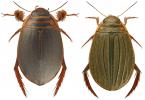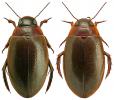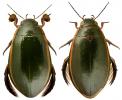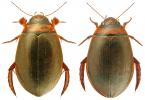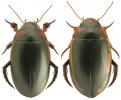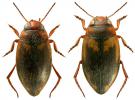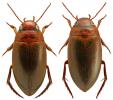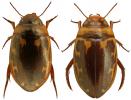Dytiscidae
Common name:
Diving beetlesNumber of species:
120Size Range:
1-38mmTarsi:
5-5-5.Images:
Description:
The largest of the water beetle families, this group consists of six subfamilies, all of which are carnivorous at both the adult and larva life stages.
Subfamily Copelatinae is largely tropical, with just one British representative, Copelatus haemorrhoidalis (Fabricius). This species is 6-8mm long, maroon-red on top with red appendages. It can be found in well-vegetated ponds and ditches, including brackish water.
The subfamily Laccophilinae has three British members, all small (3-5mm) beetles in the genus Laccophilus. The rarest of the group, Laccophilus poecilus Klug, was thought to be extinct in Britain until rediscovered near Lewes in 1996. All three species have hind tarsi comprising broad segments with long lobes below, distinct from the front and mid-tarsi which have simple segmentation. Tan-coloured with greenish hints (lost after death), they tend to inhabit the vegetated margins of large slow-flowing waterbodies. In the field they are easily recognised in the field by their ability to jump.
The remaining four subfamilies correspond roughly to the small (Hydroporinae), medium (Colymbetinae and Agabinae), and large (Dytiscinae) diving beetles, and are generally coloured black, yellow, or reddish brown. The 14 species of Dytiscinae, typified by the great diving beetle Dytiscus marginalis L. are some of the most familiar British beetles, often pictured in general guides, but there are six similar species and so species-level ID is harder than may be first thought. Females often have grooved (sulcate) elytra, while males have circular sucker pads on the fore tarsi for mating purposes.
The medium-sized diving beetles, 29 British species in Agabinae with a further 7 in Colymbetinae, are often the first water beetles to be encountered by the non-specialist. In particular, Agabus bipustulatus (L.) is a common, relatively large species which can colonise all kinds of aquatic environment, and is often found in puddles and paddling pools. Most species are usually found in vegetation and sediment around the edges of pools and rivers.
The Hydroporinae are a large group of small beetles, with 64 British species. They are often pioneer colonisers of new waterbodies (particularly Hygrotus species) or are found in shallow or ephemeral habitats. This subfamily includes genus Hydroporus, a group of 28 notoriously difficult-to-ID species in Britain, which usually require dissection of the male and the use of a good reference collection for reliable ID.
